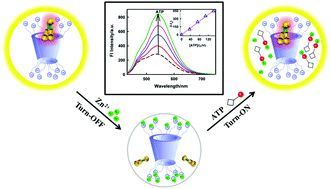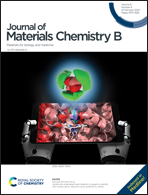A supramolecule based fluorescence turn-on and ratiometric sensor for ATP in aqueous solution†
Abstract
Considering the biological relevance of adenosine triphosphate (ATP) as an “energy currency” in all organisms and significance of its detection in various diseased conditions, enormous efforts have been made to develop selective and sensitive fluorescent sensors for the detection of ATP. However, these developed sensor probes frequently involve technically challenging and time-consuming synthetic protocols for the production of sensor molecules and often suffer from poor solubility in aqueous medium. Another major disadvantage of these developed sensor systems is their single wavelength based operation which makes their performance susceptible to minute changes in experimental conditions. Herein, we report a fluorescence turn-on ratiometric sensor for the detection of ATP which operates by the dissociation of Thioflavin-T-sulphated-β-cyclodextrin supramolecular assembly by Zn2+ followed by ATP induced reassociation of the same. This modulation of the monomer/aggregate equilibrium of the supramolecular assembly followed by subsequent interactions with Zn2+ and ATP acts as an optimal scheme for the ratiometric detection of ATP. Overall this supramolecular ensemble based sensing platform provides a simple, sensitive, selective and label free detection approach for ATP in aqueous solution. Importantly, our sensor platform responds to ATP in the biologically complex media of serum samples suggesting its potential for possible applications in real-life scenarios.

- This article is part of the themed collection: Journal of Materials Chemistry B HOT Papers


 Please wait while we load your content...
Please wait while we load your content...